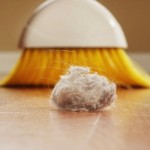
Sure, dust in your house is annoying. But did you know it could be toxic?
One study by the Silent Spring Institute identified 67 hormone-disrupting compounds in household dust tests, including flame retardants, home-use pesticides and phthalates.

The chemicals in your dust originate from inside and outside your house. Products inside your house—such as furniture, electronics, shoes, plastics, fabrics and food—shed chemicals over time. Outdoor pollutants enter on shoes and through open and cracked windows and doors
Once inside, the contaminants in indoor dust degrade more slowly—if at all—than they would outside where moisture and sunlight typically break them down.
One type of toxic chemical commonly found in household dust is chemical flame retardants, also known as PBDEs. As highly flammable synthetic materials have replaced less-combustible natural materials, PBDEs have been added to thousands of everyday products, including computers, TVs and furniture, among many others. Environmental Working Group conducted tests that revealed the surprising degree to which flame-retardant chemicals escape from consumer products and settle in household dust.
Now, a new study shows that vinyl flooring could be joining the list of household products contributing to chemical-laced household dust. Large areas of vinyl flooring in daycares and schools appear to expose children to a group of compounds called phthalates, which have been linked to reproductive and developmental problems, according to a study published recently in the American Chemical Society journal Environmental Science & Technology.
Phthalates, which increase the flexibility and durability of polyvinyl chloride (PVC), are key ingredients in PVC materials used in vinyl flooring and a wide range of other household products, including toys, food packaging and medical devices.
Like other chemicals found indoors, these additives leach out of products into the air and dust. This study is among the first to show what products were contributing to indoor phthalate levels.
Silent Spring Institute has some advice on how you can reduce your exposure:
Go natural. Select carpets, carpet pads, bedding, cushions and upholstered furniture made from naturally flame-resistant materials such as wool, polyester and hemp.
Repair ripped furniture. Flame retardants are added to polyurethane foam filling.
Keep down dust. Vacuum regularly with a vacuum cleaner fitted with a HEPA filter. Wipe surfaces with a wet cloth or mop.
Wash hands frequently. Hand washing does more than prevent the spread of germs; it also reduces the amount of flame retardants entering our bodies. Remember to use regular soap and water instead of antibacterial soaps, which may contain endocrine disrupting chemicals.
Look for snug-fitting cotton sleepwear labeled as not flame-resistant. Sleepwear for children nine months and older is subject to flammability tests.
Get involved. At the national level, Congress is considering the Safe Chemicals Act to make sure chemicals are tested for safety before going into use.
Visit EcoWatch’s HEALTH page for more related news on this topic.

[source: http://ecowatch.com/2013/11/04/reduce-exposure-toxic-dust-house/]

Leave a Reply
You must be logged in to post a comment.